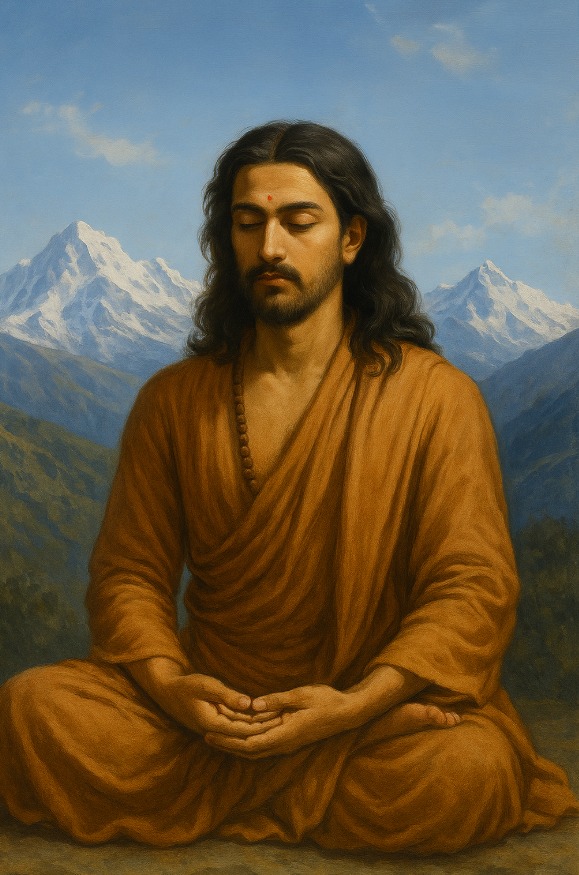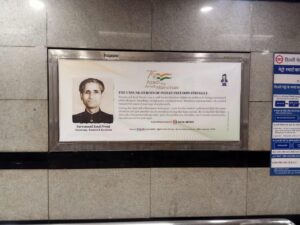Early Life and Illustrious Lineage
Family Background and Birth
Abhinavagupta was born around 950–975 CE in the beautiful valley of Kashmir. He came from a noble and learned Brahmin family known for its deep spiritual roots and scholarly traditions.
His ancestral lineage traces back to Attrigupta, a revered scholar originally from the holy region of Antarvedi (the land between the rivers Ganga and Yamuna). Attrigupta was invited to Kashmir by King Lalitaditya (reigned c. 725–756 CE), and from that point on, the family became deeply embedded in Kashmiri intellectual life. He became the most influential Sage of Kashmir Shaivism.
Abhinavagupta’s grandfather, Varahagupta, was a devout Shaiva and respected scholar. His father, Narasimhagupta, also known as Chukhala, was a revered teacher of Shaivism who personally educated Abhinavagupta in Sanskrit grammar, poetry, philosophy, and scriptures.
His mother, Vimalakala, passed away during his childhood, a loss that profoundly impacted his emotional and spiritual outlook. According to tradition, he was born of a “yogini” (a spiritually awakened woman), and is thus described as Yoginibhu, someone destined for spiritual greatness.
Educational Foundation
From an early age, Abhinavagupta showed signs of brilliance. His home environment, saturated with spiritual discourse and scholarly discipline, provided fertile ground for his awakening. His family lived by the belief that “material wealth was like straw” compared to the pursuit of divine knowledge.
As a result, young Abhinavagupta focused intensely on intellectual growth and spiritual practice. He was trained in grammar, logic, Sanskrit literature, and Vedic philosophy—a foundation that later allowed him to explore and synthesise a wide range of spiritual systems.
The Quest for Knowledge
Abhinavagupta was not content with a single school of thought. He actively sought out fifteen to nineteen different gurus, each representing a distinct philosophical tradition. He travelled extensively beyond Kashmir—engaging with Buddhist, Jaina, and various Shaivite masters—to build a comprehensive understanding of India’s spiritual wisdom.
This quest reflects his core belief: truth must be experienced from multiple angles. He wasn’t trying to prove one school superior to another; instead, he wanted to unite them into a greater understanding.
Key Teachers and Their Influence
His teacher, Lakshmanagupta, played a significant role in shaping his philosophical views. Lakshmanagupta was a disciple of Utpaladeva, author of the Ishvara Pratyabhijna Karika, a key text in the Pratyabhijna (Recognition) school of Kashmir Shaivism. Through this lineage, Abhinavagupta absorbed the teachings of Somananda and Vasugupta, regarded as the founders of this profound system.
His most revered guru, however, was Shambhunatha of Jalandhara, who initiated him into the Kaula tradition, known for its esoteric tantric practices. Abhinavagupta stated that Shambhunatha helped him attain “true peace” and referred to him as a spiritual sun that dispelled the darkness of ignorance.
Other notable teachers included Vamananatha, who taught dualistic Shaivism, and various unnamed masters who expanded his horizon across different streams of Indian thought.
The Four Upayas (Means)
Abhinavagupta described four progressive spiritual methods—called Upayas—that help individuals progress from limited awareness to divine realisation. Each path suits a different kind of seeker:
- Shambhavopaya: This is the most direct path. It’s about instant recognition of one’s true nature through pure will. There are no rituals or mental processes here—just sudden awareness. It’s best suited for highly evolved souls.
- Shaktopaya: This path uses the mind and focuses on mantra, knowledge, and subtle thought. It encourages awareness of divine energy (Shakti) and is helpful for those who can concentrate and reflect deeply.
- Anavopaya: This method is for beginners. It employs external techniques such as breath control (pranayama), rituals, and visualisation to elevate the mind toward higher states gradually.
- Anupaya: This is the “non-method.” It’s scarce and arises spontaneously when no effort is needed. The seeker abides in awareness without doing anything.
These four methods demonstrate the inclusivity of Abhinavagupta’s system. Whether someone was a scholar, a mystic, or an ordinary person, there was a path for them.
Revolutionary Social Approach
Abhinavagupta broke many barriers of his time. He believed that spiritual freedom was the birthright of every human being, not just Brahmins, monks, or men. His teachings welcomed people of all backgrounds, genders, and castes.
In his work Paramarthasara, he writes:
“On this path of Bhairava, even a sweeper or an outcaste becomes one with the Divine if he walks with pure desire.”
This was a bold vision that challenged rigid social systems. Abhinavagupta saw everyone as a spark of divine light.
Aesthetic Philosophy and Rasa Theory
The Ninth Rasa
Indian art and drama were already well-developed in Abhinavagupta’s time. But he added something that changed it forever: the ninth rasa—Shanta, the rasa of peace.
Before him, the Natyashastra spoke of eight rasas (emotions): love, laughter, anger, courage, fear, disgust, wonder, and sorrow. Abhinavagupta said that the highest emotion is tranquillity. Why? Because it reflects the calm of the soul when it is free from worldly desire.
Shanta Rasa became a bridge between art and spirituality. Through it, he demonstrated that a profound aesthetic experience can lead to inner transformation.
The Sahrdaya Concept
Another beautiful idea from Abhinavagupta is the concept of Sahrdaya—the ideal audience. A Sahrdaya is someone whose heart is tuned to beauty and emotion. They don’t just watch or read—they feel deeply.
He believed that art is incomplete without a sensitive observer. The spectator doesn’t just enjoy the show; they become part of it.
Art as Spiritual Elevation
For Abhinavagupta, art wasn’t just for fun. It was a way to connect with the higher truth. Poetry, drama, and music could lift people to a state of awareness that was almost meditative.
He taught that the best art does more than entertain—it awakens the soul.
The Cave at Birwa
According to legend, around 1025 CE, Abhinavagupta gathered 1,200 of his disciples and recited a powerful hymn—the Bhairavastava—while entering a cave in Birwa, near modern-day Magam in Kashmir.
None of them ever came out. Their disappearance remains one of the most mysterious events in Indian spiritual history. Even today, the cave draws seekers and pilgrims who wish to feel the energy he left behind.
Some believe it was a symbolic return to the source. Others think the event represents the complete union of Abhinavagupta and his disciples with Lord Shiva.
Influence on Subsequent Generations
Abhinavagupta’s legacy was carried forward by his cousin and disciple Kshemaraja, who simplified and shared his teachings. Thanks to him, many of Abhinavagupta’s texts survived.
In modern times, Swami Lakshmanjoo, a Shaivite saint from Kashmir, revived the tradition and brought it into the global spotlight. His translations and commentaries made Abhinavagupta’s works more accessible.
Today, Kashmir Shaivism is studied in universities, yoga circles, and spiritual retreats worldwide.
Contemporary Relevance and Global Impact
Modern Consciousness Studies
Philosophers, psychologists, and neuroscientists are now exploring Abhinavagupta’s ideas. His concept of consciousness as both light (prakasha) and self-awareness (vimarsha) closely matches modern theories of the mind.
His insights help people understand that true consciousness is not just awareness—it’s awareness that’s aware of itself. This idea is echoed in today’s discussions on the “hard problem of consciousness.”
Spiritual Renaissance
Many modern seekers are rediscovering Abhinavagupta’s message: You don’t have to leave the world to find God. Spiritual life doesn’t mean escape. It means seeing divinity in everything—in people, nature, emotions, and even in challenges.
He taught that absolute freedom comes not from renouncing life, but by transforming how we live it.
Academic Recognition
Today, universities across India, Europe, and the United States offer courses on Kashmir Shaivism. His texts are being translated into English, French, German, and other languages.
His influence has grown not just in spiritual circles but also among scholars of literature, psychology, aesthetics, and philosophy.
Conclusion: The Eternal Crown Jewel
Abhinavagupta is more than a historical figure. He is a beacon—a thinker who linked heaven and earth, soul and body, thought and emotion.
He taught that spiritual realisation is possible in everyday life. You don’t need to become a monk or live in a cave. You only need to awaken to your true nature.
In a world full of distractions, his message shines with clarity:
“Recognise your divinity. It’s already within you.”




